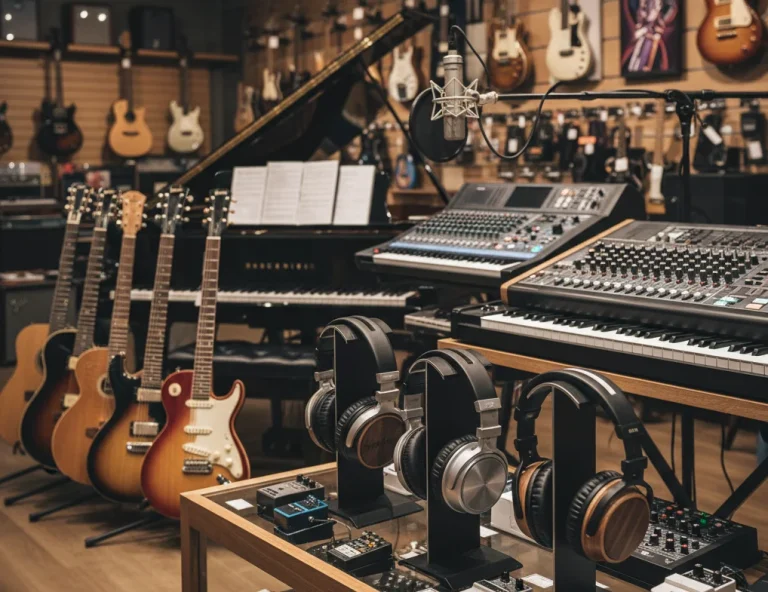All Topics
- Alchemizing Music Concepts for Students
- Artist Spotlight
- artium gift card
- Artium Maestros
- Artium News
- buying guide
- Carnatic Music
- Devotional Music
- Editorials by Ananth Vaidyanathan
- Film Music
- Guitar
- Hindustani Classical Music
- Indian Classical Music
- Indian Folk Music
- Insights
- Instruments
- Karaoke Singing
- Keyboard
- Kids Music
- maestros
- Music Education
- Music for Kids
- Music Industry
- Music Instruments
- Music Legends
- Music Theory
- Music Therapy
- Piano
- piano guide
- Success Stories
- Tamil Film Music
- Telugu Film Music
- Time Theory
- Tools
- Uncategorized
- Vocal Singing
- Vocals
- western classical music
- western music
- Western vocal music
What is the Difference Between a Violin and a Guitar?
What is the Difference Between a Violin and a Guitar?

Table of Contents
Learn the key differences between a violin and a guitar, from their structure and the number of strings to the techniques used to play them. While the violin uses a bow for its rich, classical tones, the guitar offers versatility with fingerpicking or strumming. Both instruments belong to the string family but cater to different genres and styles of music. Dive deeper into the world of string instruments and enhance your skills with Artium Academy’s expertly designed online guitar classes and courses!
But before that…
If you’re really excited to start your journey in music, start with a free trial lesson today!
Difference Between Violin and Guitar
The most obvious difference between the violin and guitar is the size. The violin is smaller in size compared to the guitar, where the size also demands that the instrument is to be held in a particular way to play it.
For a right-handed player, the body of the violin will sit between the left shoulder and the left cheek while the neck of the violin is held with the left hand. The sound on the violin is produced using a bow with the right hand. Whereas for a right-handed guitar player, the body of the guitar sits on the right thigh of the player and is held between his right elbow with the right arm hanging over the body of the guitar which is used for strumming. The left-hand holds the neck of the guitar and is used to play fretted notes.
The violin uses a violin bow to create sound while the guitar uses either the fingers or a plectrum which is mostly made of plastic.
However, the violin bow is a unique little instrument in its own way. It comprises the stick, hair, ‘frog’ which is also the grip area and the tip plate. The stick is usually made of high-quality wood known as pernambuco wood, which comes from the Pau Brasil tree that is native to Brazil. However, due to scarcity and conservation concerns, carbon fibre is widely used these days. The hair of the bow is typically made from the tail of white horses, preferably from colder climates, due to its strength and durability. A substance known as ‘sap’ is applied to the hair of the bow to create friction between the strings and the bow. The frog or the grip area, holds the hair at one end and has a mechanism to adjust the tension of the hair. The tip plate protects the fragile end of the stick and is reinforced with ivory, bone or other synthetic materials.
The bodies of both violin and guitar are traditionally made of wood. Violin and acoustic guitar are both hollow-bodied. The electric guitar is usually a solid body made of wood.
The Violin has 4 strings while the guitar usually has 6 strings. The strings of both these instruments are made from steel. The violin is tuned in 5ths while the guitar is tuned in 4ths and a third. The exact tuning for violin from lowest to the highest strings is G, D, A, E while for guitar it is E, A, D, G, B, E.
The Unique Nature of Violin & Guitar
As you can see, the guitar and violin are quite similar in terms of their build and looks. However, the one difference that sets them apart is the presence and absence of frets on the fretboard. The violin is a fretless instrument, while the guitar has frets.
The fretless nature of the violin paired with the bow creates one of the most unique sounds, which is smooth, sustained and focused. This also makes the violin one of the most difficult instruments to learn. On the other hand, a larger fretboard with around 20 frets over 6 strings allows the guitar to have a huge range of frequencies.
The techniques used in violin and guitar are quite similar as well. Techniques like legato, staccato, and tremolo are used for both violin and guitar. However, the way these techniques are implemented differs. Most of the techniques in the violin are created with the right hand using the bow. In the guitar, the legato is a completely left-handed technique, while tremolo is primarily a right-handed technique which uses a plectrum.
Sonic Difference between Violin and Guitar
The violin is primarily an acoustic instrument. Sound is produced by drawing the bow across the strings creating continuous friction. This allows the sound to be sustained and dynamic. The notes can be sustained indefinitely with the bow. The vibrations of the strings resonate through the hollow wooden body, which amplifies the sound naturally. The fretless nature combined with the bow makes the violin capable of dramatic dynamics with nuanced expressions. This allows the sound to be extremely lyrical and melodic.
The guitar started as an acoustic instrument, however, it has evolved drastically through time making it one of the most versatile instruments ever, in terms of sonic possibilities. One of the major turning points for the guitar was its evolution into an electric guitar with distorted sound. This started a whole new wave of rock music which later evolved into numerous subgenres like blues rock, heavy metal, etc. The classical or acoustic guitar can produce mellow notes with rich timbre and overtones. Whereas, the electric guitar can create heavy distortion tones or overdrive lead tones with numerous effects like overdrive, reverb and delay which are extensively used in creatic melodic lead lines and solos.
Uses in Music
The violin is generally played in classical music and plays an extremely important role in an orchestra. The violin is also played as a solo instrument along with an orchestra. You can also find the use of the violin in jazz and folk music.
The guitar’s ability to be a harmonic, as well as a melodic instrument makes it a favourite in blues, jazz, rock and modern pop genres.
Should I Learn The Violin or The Guitar?
The most important question to ask yourself is are you ready for a sincere commitment in practising the instrument consistently for over 8 to 12 months? If the answer is yes, then you can go for the violin. As we have discussed, the violin is one of the most difficult instruments to learn. However, if one is willing to put in the necessary efforts with dedication, the rewards are equally satisfying.
Conclusion
The guitar is more beginner-friendly in comparison to the violin. Its ability to harmonically accompany singers makes it a popular instrument. With regular practice, one can learn to play the guitar a little faster than the violin. At Artium Academy, we have a structured guitar course curriculum designed by industry experts that offers a holistic music education to music enthusiasts alike. Our personalised 1:1 LIVE learning approach ensures that strong foundational level skills are built in a student.






